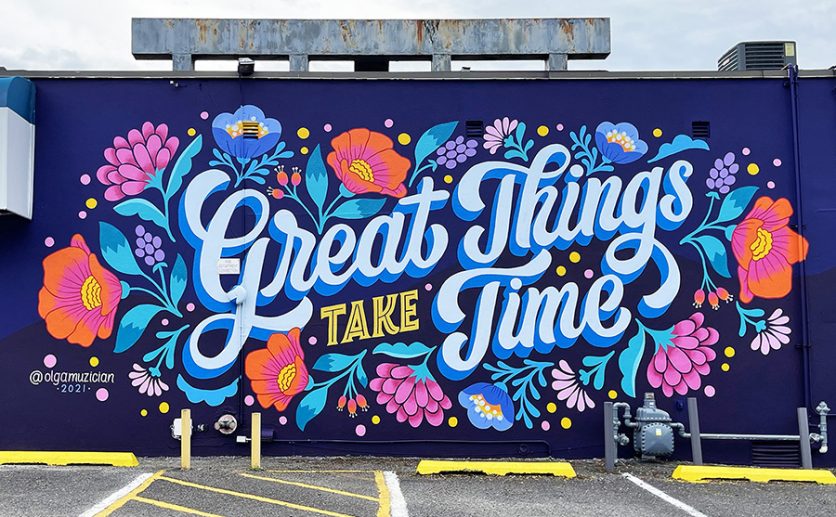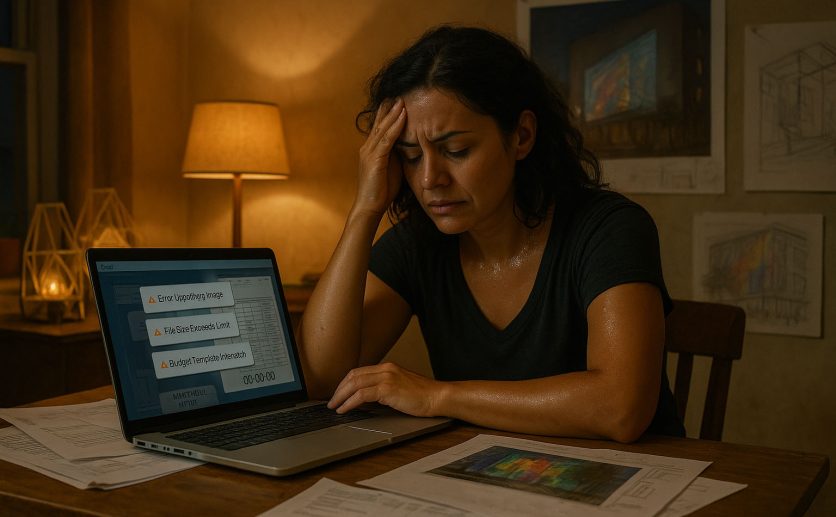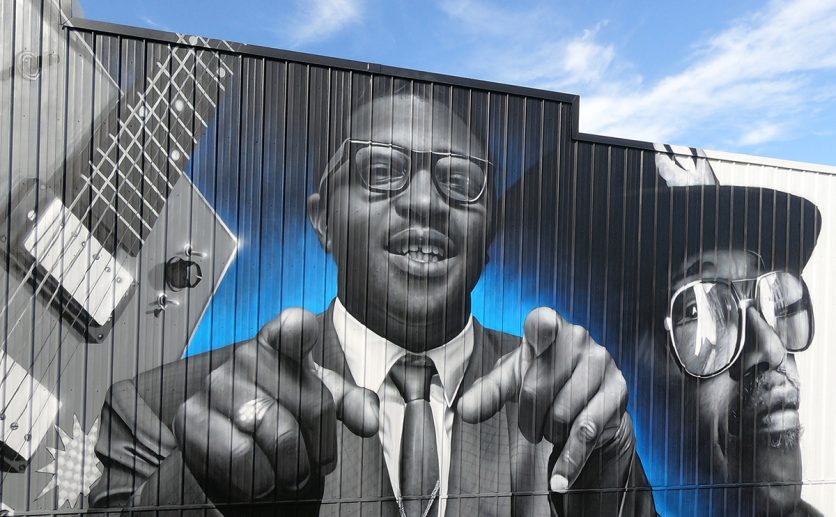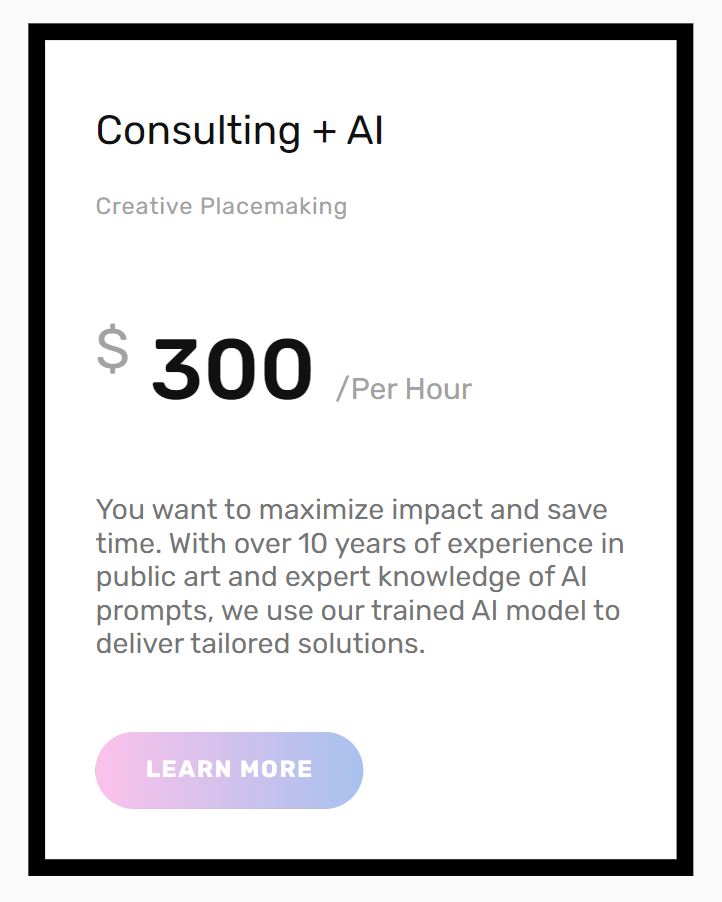Proposed Guidelines for Public Art Projects: Enhancing Engagement and Inclusivity
Public art plays a vital role in creating vibrant and inclusive communities. It enhances public spaces, fosters cultural expression, and encourages community engagement. To ensure the success of public art projects, it is crucial to follow best practices that promote accessibility, diversity, and transparency. This article outlines key guidelines for creating impactful public art installations based on resources from Americans for the Arts (AFTA), and has been elaborated by Monochronicle to provide comprehensive recommendations for public art projects. These guidelines aim to foster transparency, diversity, and inclusivity in the field, serving as a valuable resource for administrators, artists, and public art professionals. By incorporating these practices, projects can strive for excellence and meaningful community engagement. On the cover: mural by Olga Muzician, Monochronicle Network.
Artist Selection Process:
1. Administrators should clearly communicate the project’s scope, medium (mural, sculpture, etc), and budget in Calls for Artists and all related communications, enabling artists to make informed decisions.
2. Artists should follow the process and provide all requested information and an accurate portrayal of their roles and past work when presenting portfolios, ensuring transparency and integrity.
3. Artists should design within the available budgets and propose realistic ideas that align with the project’s financial constraints, particularly during design competitions. This encourages feasibility and avoids resource gaps.
4. Administrators and consultants should refrain from requesting artists to appropriate or use designs proposed by other artists in competitions. Likewise, artists should not exploit ideas or concepts presented by fellow competitors. Respecting intellectual property promotes fairness and ethical practices.
5. Organizations commissioning artwork should compensate artists for their design proposals, acknowledging their contributions and efforts.
6. Administrators should establish a fair and transparent process for project development and artist selection, ensuring equal opportunities for all artists.
7. When developing projects and selecting artists, commissioning bodies should align their processes with the principles of cultural equity, as outlined in the Americans for the Arts Statement on Cultural Equity. This promotes inclusivity and diversity in public art projects.
8. Administrators should safeguard artists’ private information in accordance with privacy policies and legal requirements.
9. Involving arts professionals in the artist selection process brings expert perspectives and facilitates informed decision-making.
10. Administrators and consultants should not accept monetary or other forms of compensation from artists being considered or awarded a project, maintaining the integrity of the selection process.
11. To prevent conflicts of interest, all parties involved should disclose any potential conflicts, and decision-makers with conflicts should abstain from participating in the selection process.
Open call for artists:
12. Announce an open call for artists, inviting submissions from a wide range of individuals. This helps create a diverse pool of applicants and ensures equal opportunities for all artists.
13. Selection committee: Establish a selection committee comprising diverse stakeholders, including community members, artists, arts professionals, and representatives from relevant organizations. This committee should have a fair and transparent selection process.
14. Transparent criteria: Clearly communicate the selection criteria to all applicants and ensure they align with the project’s goals and objectives. The criteria may include artistic quality, experience, community engagement skills, and alignment with the project’s theme.
15. Anonymous review: Consider implementing an anonymous review process where the selection committee evaluates the artwork proposals without knowledge of the artists’ identities. This helps reduce biases and focuses solely on the artistic merit of the proposals.
16. Evaluation rubric: Develop an evaluation rubric to guide the selection committee’s decision-making process. The rubric should assess criteria such as artistic excellence, innovation, community engagement potential, and feasibility.
17. Panel discussion: Organize a panel discussion or interview with shortlisted artists to gain a better understanding of their artistic vision, community engagement approach, and ability to execute the project successfully.
18. Collaboration opportunities: Encourage artists to collaborate with community members, local organizations, or other artists to enhance community involvement and create more impactful and culturally relevant artworks.
Agreements and Project Execution:
19. Contract and agreements: Once an artist is selected, ensure the artist’s responsibilities, compensation, timeline, and ownership rights are clearly outlined in a written contract or agreement. This provides a framework for the successful completion of the project.
20. All projects should have written agreements that clearly define the scope of work, budget, and schedule, ensuring clarity and alignment between all parties involved. Sample documents provided by Americans for the Arts can serve as valuable resources.
21. Sufficient time should be provided for all parties to review and understand agreements before signing, and artists should be encouraged to seek legal or business counsel when necessary.
22. Agreements should establish a clear process for approving project changes, ensuring that modifications are documented in writing. This promotes accountability and minimizes misunderstandings.
23. In cases where significant redesign or proposal changes are requested, artists should be fairly compensated if the changes are unrelated to any faults on their part.
24. The expected lifespan of an artwork should be mutually agreed upon and specified in the agreement, facilitating proper planning for maintenance and conservation.
25. Artists should select materials appropriate for the expected lifespan of their artwork, taking care to integrate components that align with the minimum warranty period required in the agreement. Attention should be given to integrated components that may affect underlying warranties.
26. Artist warranties should not exceed two years, maintaining a reasonable level of responsibility considering the dynamic nature of artistic works.
27. Artists should only pass along manufacturer warranties for integrated components, ensuring transparency and appropriate allocation of responsibility
Insurance and Liability:
28. Administrators should collaborate with artists to assess the true cost of obtainable insurance, as required by law or municipal policies. Non-licensed artists may be exempt from obtaining professional liability and errors and omissions insurance, while licensed subcontractors may still be subject to these requirements.
29. Administrators should avoid imposing unreasonable or inappropriate liability burdens on artists, ensuring fairness and proportionality.
30. Artists should establish written agreements with their subcontractors, incorporating all relevant requirements from the prime contract to maintain consistency and clear expectations.
Credit, Copyright, and Maintenance:
31. Project payment schedules should align with the cash flow needs of the artwork’s deliverables, providing artists with adequate support throughout the project timeline.
32. Artists should retain copyright to their artwork. However, artists should be open to granting licenses to the contracting agency or ultimate owner for reasonable use of artwork images, subject to mutual agreement and for purposes such as publicity, education, and promotion.
33. Artists and commissioning bodies or owners should mutually credit and acknowledge each other’s roles in commissioned artworks, recognizing the collaborative nature of public art projects.
34. Maintenance and Conservation: Regular maintenance and conservation are essential for preserving the integrity and longevity of public art. Administrators should establish clear maintenance plans and allocate resources for ongoing care, including periodic cleaning, repairs, and necessary conservation treatments. Engaging professional conservators and involving artists in the long-term maintenance process can ensure the artwork’s sustained quality and appearance.
35. Detailed and feasible maintenance and conservation plans should be discussed and agreed upon by all parties involved, ensuring the long-term preservation and enjoyment of the artwork.
36. Commissioning bodies or ultimate owners should have established collection management policies and should inform artists of these policies, promoting responsible stewardship of the artwork.
37. In the event of artwork damage, administrators should consult with artists in good faith regarding repairs, adhering to best conservation practices.
38. In cases where Visual Artist Rights Act (VARA) rights are waived, agreements should still grant artists the right to remove their names from artworks if damage, alteration, or relocation occurs without the artist’s approval, and if the artwork no longer represents their vision.
Community Engagement:
39. Successful public art projects prioritize meaningful community engagement throughout the entire process. Administrators should actively involve local residents, community organizations, and stakeholders in the planning, design, and implementation phases. This can include hosting public meetings, workshops, and open forums to gather input, ideas, and feedback from the community. By incorporating diverse perspectives, projects can reflect the values and aspirations of the community they serve.
40. Artistic Diversity and Representation: Embracing artistic diversity and ensuring equitable representation is crucial in public art projects. Administrators should actively seek opportunities to collaborate with artists from diverse backgrounds, cultures, and perspectives. This can lead to the creation of artworks that celebrate the richness of cultural diversity and promote inclusivity. Efforts should be made to prioritize underrepresented artists, fostering a more inclusive and representative public art landscape.
41. Accessibility and Inclusivity: Public art should be accessible and inclusive to all members of the community. Administrators should consider the physical and sensory accessibility of the artwork, ensuring that it can be experienced by individuals with disabilities. This can involve providing wheelchair-accessible paths, tactile elements for visually impaired individuals, or multilingual interpretive materials. By prioritizing accessibility, public art projects become more welcoming and inclusive spaces for everyone to enjoy.
42. Documentation and promotion: Document the process and outcomes of public art projects through photography, videos, or written materials. Share this content through various channels, such as social media, websites, or local media, to raise awareness and engage a wider audience.
43. Public input and feedback: Encourage ongoing public input and feedback regarding public art projects. This can be done through surveys, community meetings, or online platforms, ensuring that the community’s voice remains central to the process. Regularly evaluate the impact of public art projects on the community. Assess how the artwork has influenced public spaces, community pride, social cohesion, and engagement.
44. Public-private partnerships: Foster collaborations between public entities, private organizations, and philanthropic foundations to leverage resources and expertise. Such partnerships can provide additional funding, access to venues, or support in community engagement efforts.
45. Celebrate diverse cultures and histories: Public art can serve as a platform to acknowledge and celebrate the diverse cultures and histories within a community. Incorporating stories, symbols, or traditions from different cultural backgrounds can foster a deeper sense of belonging and mutual understanding.
Cite-Specificity:
46. Public art should be thoughtfully integrated into the surrounding environment, considering the unique characteristics, history, and culture of the site. Artists and administrators should collaborate to ensure that artworks harmonize with the existing landscape, architecture, and community context. This can be achieved through site visits, research, and dialogue to create site-specific installations that resonate with the local community and create a sense of place.
47. Sustainability and Environmental Responsibility: Public art projects should strive to be environmentally responsible and sustainable. Artists and administrators should consider utilizing materials and techniques that minimize negative environmental impacts. This can involve incorporating recycled or repurposed materials, utilizing energy-efficient lighting, or implementing eco-friendly maintenance practices. By integrating sustainability into public art projects, they can become catalysts for environmental awareness and inspire sustainable practices.
48. Education and Interpretation: Public art should provide opportunities for educational engagement and interpretation. Administrators can incorporate educational elements such as signage, plaques, or interactive components that offer insights into the artwork’s conceptual framework, artistic process, and historical context. Additionally, partnerships with local educational institutions and organizations can be established to develop educational programs and workshops that enhance public understanding and appreciation of the artwork.
49. Temporary and Pop-up Installations: Temporary and pop-up public art installations offer opportunities for experimentation, creativity, and engaging the community in new and unexpected ways. Administrators can collaborate with artists to organize temporary exhibitions, street art festivals, or interactive installations that activate underutilized spaces. These temporary installations can breathe new life into urban areas, stimulate dialogue, and foster a sense of discovery and excitement among the public.
Processes to Avoid Biases in Artist Selection:
50. Anonymous portfolio review: Implement an initial review process where the selection committee assesses artists’ portfolios without access to their personal information, ensuring a fair evaluation based solely on artistic merit.
51. Diversity in the selection committee: Ensure the selection committee represents a diverse range of backgrounds, including race, ethnicity, gender, age, and artistic expertise. This diversity helps prevent biases and provides multiple perspectives during the selection process.
52. Implicit bias training: Conduct implicit bias training for the selection committee members to raise awareness about unconscious biases and promote fair decision-making.
53. Blind voting: Consider using blind voting methods, where the selection committee members vote anonymously for their preferred artists. This approach reduces the influence of personal relationships or biases on the final selection.
54. Community involvement: Seek input from the community during the artist selection process. This can include community representatives serving on the selection committee or organizing public voting to determine artists for certain projects.
55. Artist statements: Emphasize the importance of artist statements that focus on their artistic vision and approach rather than personal background or identity. This helps the selection committee focus on the artworks’ qualities rather than demographic factors.
Conclusion:
These proposed guidelines for public art projects, developed by Monochronicle based on resources from Americans for the Arts, provide a comprehensive framework to enhance engagement, inclusivity, and excellence in the field of public art. By adhering to these best practices in public art, communities can create engaging, inclusive, and meaningful spaces that reflect their values and aspirations. Additionally, incorporating processes to avoid biases in artist selection ensures equitable opportunities for artists and fosters diversity and representation in public art projects. Through thoughtful planning, community engagement, and a commitment to accessibility, public art can truly enrich the lives of people and transform public spaces into vibrant cultural landscapes.




